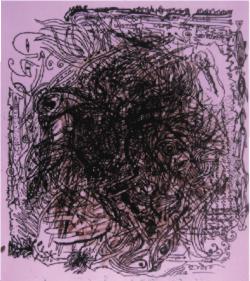Habibur
Rahman's Arcadian World
Artist
Habibur Rahman left the country in the early 90s. He got married
to an Indian woman, and due to procedural complications in becoming
an Indian citizen, stayed there for ten years. Last year he had
a group show at Drik. This year he is holding a show at the Gallery
Chitrak. His style has gone through different phases, now it is
nature that he is concern with. SWM talks with him in this regard.
SWM:
There is an affinity towards fairytale in your recent pictures,
tell us about it?
Habibur
Rahman(HR): I have always been attracted to fairytales.
And the ten years spent in Kolkata was a time that induced nostalgia
for my homeland. I was born in Chapainawabganj, my recent preoccupation
with my childhood memories reminds me more of the indigenous fairytales
and folklore.
SWM:
You used to be a politically inclined artist, what made you change
course?
HR:
That was when I was with the group Shomoi. My friends were into
political art; I was too. During the autocracy we were witnesses
to a lot of oppression and political unrest. Therefore, I, along
with my friends attempted to reflect on political subject matter.
Now that I am far removed from the reality of my homeland, I am
less effected by the turn of events in the political arena of
Bangladesh. My recent works are even thematically different from
what I showed in last year's group show.

'Homage
to Leonardo', Mixed Media.
SWM:
Nature seems to have taken the centre stage now.
HR:
Vegetation, birds and humans are in a harmony in my work. Birds
are one of the prominent elements. Birds can freely fly from one
country to another, this aspect has made me use them as leitmotif.
Birds are the symbol of freedom of travel, of free movement. I
often think that how restricting our existence is. Alongside birds
and other elements I have incorporated words-- expressing my willingness
to connect with my friends at home. I picked up lines from popular
songs. “Friend, how are you, how have you been?” or lines from
any other contemporary songs that can express my feelings and
sentiment I put in writing. Sometimes I make them intentionally
jumbled. These elements are drawn from real life, abstraction
provides little attraction for me. If it comes naturally, I would
not mind doing abstraction.
SW:
You don't believe in formalism?
HR:
If I ever feel like doing abstract pictures then I would. But,
drawing or the play of line is something that I would never want
to renounce. It is a quality that I picked from printmaking, a
subject that I specialised in. You know those mediums-- etching,
aquatint, lithography and woodcut. Except for lithograph they
are all linear mediums.
SWM:
Will you again be interested in making pictures that question
the social or political order?
HR:
I was concerned with politics when I was in Dhaka. But now that
has changed. In Kolkata, I feel like an outsider. So, my concern
with other things have taken over and nature is attracting me
more.

'Drawing',
Pen & Ink.
SWM:
Have you any favourite artist?
HR:
At home it was Zainul Abedin, Kamrul Hasan, Shafiuddin Ahmed and
Mohammad Kibria, in the greater arena David Hockney always inspired
me. At Baroda, when I went there to study, Golam Md. Sheikh and
Bhupen Khakkar amazed me. Ganesh Pine of Kolkata too is one of
my favourite artists. Picasso's linear way of representation was
always an inspiration. I had this opportunity to see a grand Picasso
show in India, I was moved to see how simply he could apply the
lines. Rembrandt's linear work too was something closer to my
heart. I did my Masters Degree dissertation on him.
SW:
Line is where your interest lies. Rembrandt has an influence on
you?
HR:
That the spectators will say.
SWM:
What about the social aspect of art?
HR:
I feel that the artist should be committed to his own society.
And by commitment I don't necessarily mean a political one. There
is this 'feeling' for or a sense of belonging to a particular
society. I have worked in the mode of the kantha makers. The way
a kantha can be seen from all four corners. My recent works too
is based on that mode.
SWM:
Was there a conscious effort in connecting with your own society?
HR:
I worked with Arong for many years. And this left a lasting imprint
on me. That experience is surfacing in my work either consciously
or subconsciously. When I paint pictures, the first thing that
comes to mind is the human. I am a human, and I often feel that
if a guy from the street is given my life to live, he would be
able to be what I am, feel what I feel. I keep inside me the idea
of the simple man alive.


